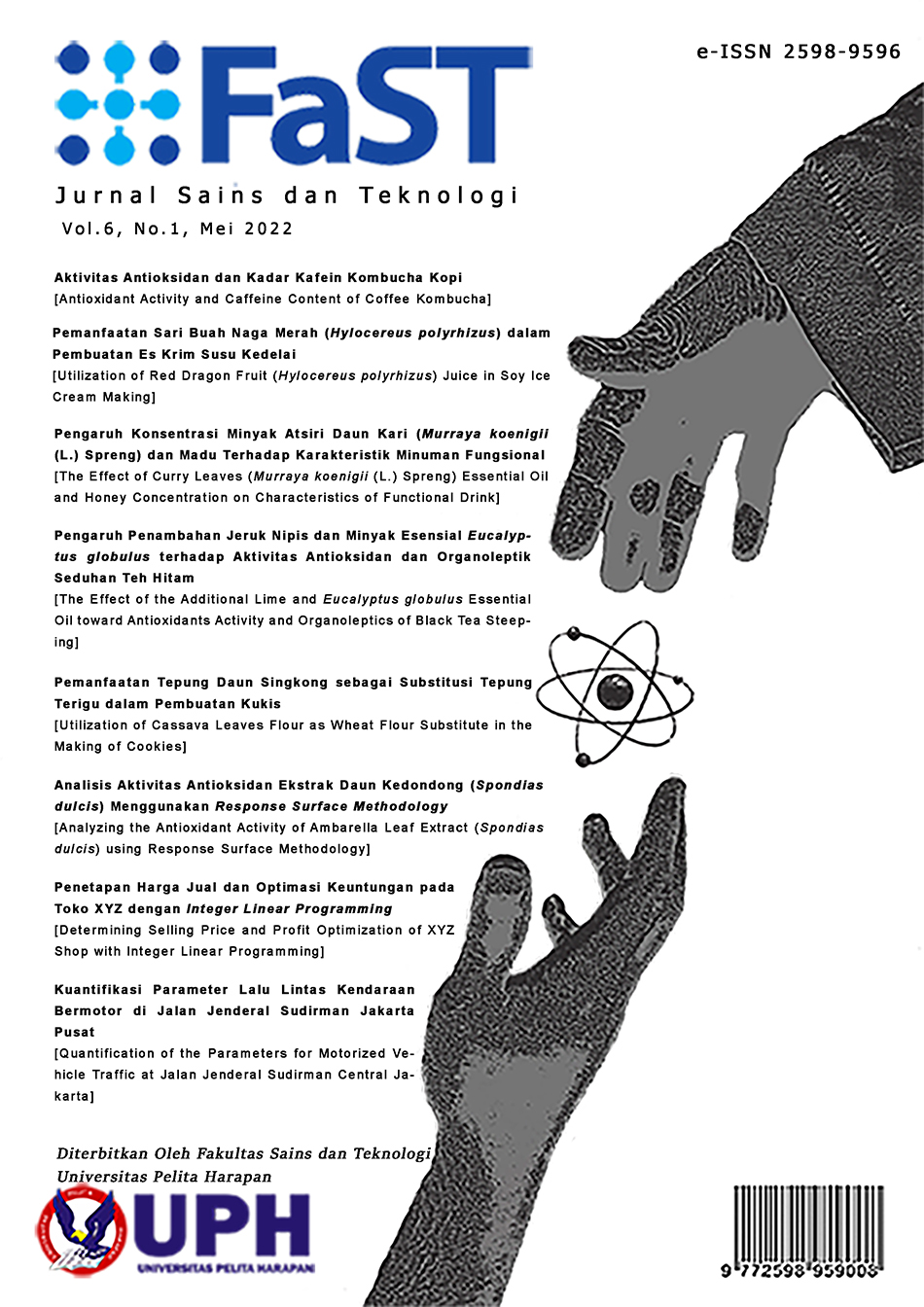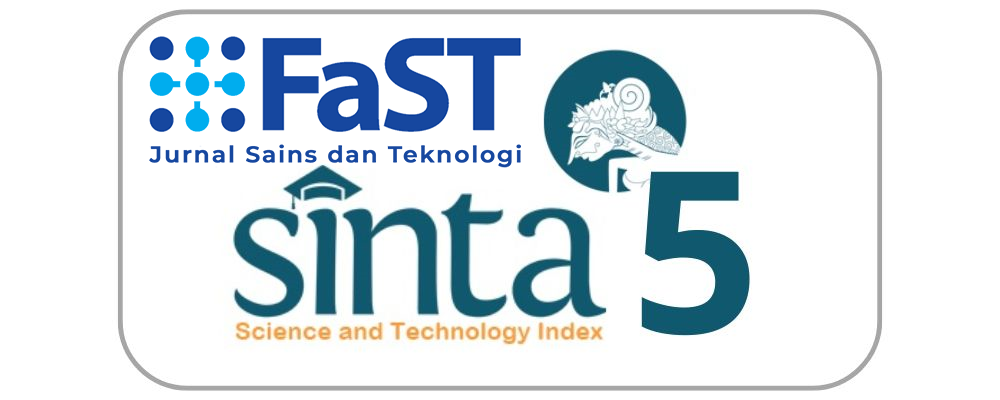Pemanfaatan Tepung Daun Singkong sebagai Substitusi Tepung Terigu dalam Pembuatan Kukis [Utilization of Cassava Leaves Flour as Wheat Flour Substitute in the Making of Cookies]
DOI:
https://doi.org/10.19166/jstfast.v6i1.5284Keywords:
cassava leaves, cookies, dietary fibre, proteinAbstract
Cookies are a product commonly made from wheat flour as the main ingredient and widely consumed by people. However, gluten in wheat flour can cause allergies, so the consumption of wheat-based products is limited. Furthermore, cookies also have low levels of protein and dietary fibre. Therefore, it is necessary to find another raw materials as an alternative in the making of cookies. In this research, wheat flour substituted with cassava leaves flour in various ratios (100:0; 90:10; 80:20; 70:30, and 60:40). The results showed that substituting wheat flour with cassava leaves flour at a ratio of 70:30 was the preferred ratio in making cookies. The resulting cookies have 10.24±0.11% of protein, 15.98±0.05 % of dietary fibre, 77.05 % of spread ratio, and 3512.47±126.68 g of hardness. In addition, the resulting cookies have slightly intense of cassava leaves aroma (4.88±1.17), slightly intense of cassava leaves taste (4.88 ±1.24), sandy (3.80±1.30) and hard (4.88±0.97) texture. The panellist slightly dislike the aroma (3.40±1.46) and taste (3.23±1.48). Meanwhile, the panellist slightly like the hardness of cookies (5.35±0.83). Further the panellist gave neutral acceptance on the sandy texture (4.75±1.54) and overall cookies (4.28±1.43).
Bahasa Indonesia Abstract:
Kukis merupakan salah satu jenis produk yang menggunakan tepung terigu sebagai bahan baku utama. Namun gluten pada tepung terigu dapat menyebabkan alergi sehingga konsumsi produk berbasis terigu menjadi terbatas. Selain itu kukis juga memiliki kadar protein dan serat pangan yang rendah, oleh sebab itu perlu dicari alternatif bahan baku utama dalam pembuatan kukis. Pada penelitian ini tepung terigu akan disubstitusi dengan tepung daun singkong pada berbagai rasio (100:0; 90:10; 80:20; 70:30, dan 60:40). Hasil menunjukkan bahwa substitusi tepung terigu dengan tepung daun singkong pada rasio 70:30 merupakan rasio terpilih dalam pembuatan kukis. Kukis yang dihasilkan memiliki memiliki 10,24±0,11 % protein, 15,98±0,05 % serat pangan, spread ratio 77,05 %, dan kekerasan 3512,47±126,68 g. Selain itu kukis pada rasio terpilih agak beraroma khas daun singkong (4,88±1,17), agak terasa daun singkong (4,88±1,24), memiliki tekstur berpasir (3,80±1,30) dan keras (4,88±0,97). Panelis agak tidak suka terhadap aroma (3,40±1,46) dan rasa 3,23±1,48). Namun, panelis agak menyukai tekstur kukis (5,35±0,83). Selain itu, panelis tingkat kesukaan netral diberikan panelis terhadap tekstur berpasir (4,75±1,54) dan penerimaan keseluruhan (4,28 ± 1,43).
References
Ajila, C. M., Leelavathi, K., & Rao, U. J. S. P. (2008). Improvement of dietary fiber content and antioxidant properties in soft dough biscuits with the incorporation of mango peel powder. Journal of Cereal Science, 48, 319-326. https://doi.org/10.1016/j.jcs.2007.10.001
Association of Official Analytical Chemists (AOAC). (1995). Official Methods of Analysis of the Association of Official Analytical Chemists. Association of Official Analytical Chemists.
Association of Official Analytical Chemists (AOAC). (2005). Official Methods of Analysis of the Association of Official Analytical Chemists. Association of Official Analytical Chemists.
Badan Standarisasi Nasional (BSN). (2011). SNI 2973:2011. Syarat Mutu Biskuit. Jakarta: Badan Standarisasi Nasional.
Badan Pustaka Statistik (BPS). (2018). Rata-rata konsumsi per kapita tepung terigu, 2014 - 2018. Retrieved March 10, 2022 from http://epublikasi.setjen.pertanian.go.id/epublikasi/StatistikPertanian/2018/Konsumsi/Statistik_Konsumsi_Pangan_Tahun_2018/files/assets/basic-html/page30.html
Badan Pustaka Statistik (BPS). (2020). Statistik Konsumsi Pangan Tahun 2020. Retrieved March 17, 2022 from http://epublikasi.setjen.pertanian.go.id/epublikasi/StatistikPertanian/2020/Statistik_Konsumsi_Pangan_Tahun_2020/files/assets/basic-html/page34.html
Baljeet, S. Y., Ritika, B. Y., & Roshan, L. Y. (2010). Studies of functional properties and incorporation of buckwheat flour for biscuit making. International Food Research Journal, 17, 1067-1076.
Choiriyah, N. A. (2020). Inkorporasi tepung garut dan buah pisang kepok pada pembuatan biskuit dengan klaim tinggi serat serta tinjauan nilai cerna pati in vitro dan gula total. Jurnal Gizi Prima (Prime Nutrition Journal), 5(2), 81-85. https://doi.org/10.32807/jgp.v5i2.197
Dachana, K. B., Rajiv, J., Indrani, D., & Prakash, J. (2010). Effect of dried Moringa leaves on rheological, microstructural, nutritional, textural, and organoleptic characteristics of cookies. Journal of Food Quality, 33, 660-677. https://doi.org/10.1111/j.1745-4557.2010.00346.x
Dewi, D. P. (2018). Kelor leaf flour substitution of cookies on physical and organoleptic characteristic, proximate content, and iron level. Ilmu Gizi Indonesia, 1(2), 104-112. https://doi.org/10.20884/1.jgipas.2020.4.2.2794
EFSA Panel on Dietetic Products, Nutrition and Allergies (NDA). (2015). Scientific Opinion on the substantiation of a health claim related to fat”free yogurts and fermented milks complying with the specifications “fat free”,“low in sugars”,“high protein”,“source of calcium” and “source of vitamin D” for nutrition claims and reduction of body and visceral fat while maintaining lean body mass in the context of an energy”restricted diet pursuant to Article 13.5 of Regulation (EC) No 1924/2006. EFSA Journal, 13(1), 3948. https://doi.org/10.2903/j.efsa.2015.3948
Harmayani, E., Murdiati, A., & Griyaningsih, G. (2011). Karakterisasi pati ganyong (Canna edulis) dan pemanfaatannya sebagai bahan pembuatan cookies dan cendol. Jurnal Agritech, 31(4), 297-304. https://doi.org/10.22146/agritech.9637
Hernaman, I, Budiman, A., Nurachma, S., & Hidayat, K. (2014). Kajian in vitro penggunaan limbah perkebunan singkong sebagai pakan domba. Pastura, 4(1). https://doi.org/10.24843/Pastura.2014.v04.i01.p07
Jannah, M., & Saragih, B. (2019). Pengaruh tepung daun singkong (Manihot utilissima) terhadap sensori dan aktivitas antioksidan beras analog. Jurnal Pertanian Terpadu, 6(2), 96-108. https://doi.org/10.36084/jpt..v6i2.171
Karri, V. R., & Nalluri, N. (2016). Cassava: meeting the global protein need. Plant Science Today, 3(3), 304-311. https://doi.org/10.14719/pst.2016.3.3.249
Kaur, M., Singh, V., & Kaur, R. (2017). Effect of partial replacement of wheat flour with varying levels of flaxseed flour on physicochemical, antioxidant, and sensory characteristics of cookies. Bioactive Carbohydrates and Dietary Fibre, 9, 14-20. https://doi.org/10.1016/j.bcdf.2016.12.002
Laguna, L, Varela, P., Salvador, A., & Fiszman, S. (2013). A new sensory tool to analyse the oral trajectory of biscuits with different fat and fibre contents. Food Research International, 51, 544 - 553. https://doi.org/10.1016/j.foodres.2013.01.003
Latif, S., & Müller, J. (2015). Potential of cassava leaves in human nutrition: a review. Trends in Food Science, 44(2), 147-158. https://doi.org/10.1016/j.tifs.2015.04.006
Montagnac, A. J., Davis, C. R., & Tanumihardjo, S. A. (2009). Nutritional value of cassava for use as staple food and recent advancances for improvement. Comprehensive Reviews in Food Science and Food Safety, 8(3), 181-194. https://doi.org/10.1111/j.1541-4337.2009.00077.x
Nguyen, D. Q. T., & Preston, T. R. (2004). Effect of method of processing cassava leaves on intake, digestibility and N retention by Ba Xuyen piglets. Livestock Research for Rural Development, 16(80).
Nguyen, T. H. L., Ngoan, L. D., Bosch, G., Verstegen, M. W. A., & Hendricks, W. H. (2012). Ileal and total tract apparent crude protein and amino acid digestibility of ensiled and dried cassava leaves and sweet potato vines in growing pig. Animal Feed Science Technology, 172(3), 171-179. https://doi.org/10.1016/j.anifeedsci.2011.11.009
Nu'man, T. M., & Bahar, A. (2021). Tingkat kesukaan dan nilai gizi cookies dengan penambahan tepung daun katuk dan tepung daun kelor untuk ibu menyusui. Jurnal Agroteknologi, 15(02), 94-104. https://doi.org/10.19184/j-agt.v15i02.24960
Poonsri, T., Jafarzadeh, S., Ariffin, F., Abidin, S. Z., Barati, Z., Latif, S., & Muller, J. (2019). Improving nutrition, physicochemical and antioxidant properties of rice noodles with fiber and protein-rich fractions derived from cassava leaves. Journal of Food and Nutrition Research, 7(4), 325-332. https://doi.org/10.12691/jfnr-7-4-10
Rachdiansyah, D., Novidahlia, N., & Amalia, L. (2016). Formulasi kerupuk dengan penambahan daun kelor (Moringa oleifera). Jurnal Pertanian, 7(2), 51-66.
Rojo-Poveda, O., Barbosa-Pereira, L., Orden, D., Stevigny, C., Zeppa, G., & Bertolino, M. (2020). Physical properties and consumer evaluation of cocoa bean shell-functionalized biscuits adapted for diabetic consumers by the replacement of sucrose with tagatose. Foods, 9(814), 1-16. https://doi.org/10.3390/foods9060814
Romeo, F. V., Luca, S. D., Piscopo, A., Santisi, V., & Poiana, M. (2010). Shelf life of almond pastry cookies with different types of packaging and levels of temperature. Food Science and Technology International, 16(3), 233-240. https://doi.org/10.1177/1082013209353836
Saputri, G. A. R., Tutik, T., & Peratasari, A. I. (2019). Penetapan kadar protein pada daun kelor muda dan daun kelor tua (Moringa oleifera L) dengan menggunakan metode Kjeldahl. Jurnal Analisis Farmasi, 4(2), 108-116. https://doi.org/10.33024/jaf.v4i2.2089
Salata, C. C., Leonel, M., Trombini, F. R. M., & Mischan, M. M. (2014). Extrusion of blends of cassava leaves and cassava flour: physical characteristics of extrudates. Food Science and Technology, 34(3), 501-506. https://doi.org/10.1590/1678-457x.6337
Santoso, I. A. (2011). Serat pangan (dietary fiber) dan manfaatnya bagi kesehatan. Magistra, 23(75), 35.
Seftiono, H., Djiuardi, E., & Pricila, S. (2019). Analisis proksimat dan total serat pangan pada crackers fortifikasi tepung tempe dan koleseom (Talinumtiangulare). Agritech, 39(2), 160-168. https://doi.org/10.22146/agritech.29726
Setyowatik, A. T., & Sarofa, R. N. U. (2017). Pengaruh suhu dan waktu pengeringan terhadap aktivitas antioksidan dan komponen fungsional daun kelor (Moringa Oleifera Lam). Jurnal Teknologi Pangan, 6(2).
Soedirga, L. C., Matita I. C., & Wijaya, T. E. (2021). Pemanfaatan tepung komposit berbasis ubi ungu dan kembang kol dalam pembuatan food bar bebas gluten. Jurnal Sains dan Teknologi, 5(1), 1-14.
Suryadi, T., Darwanto, D. H., & Widodo, S. (2012). Pendugaan Model Permintaan Ubi Kayu di Indonesia. Prosiding Seminas, 1(2).
United States Department of Agriculture. (2019). Wheat Flour, Whole Grain. Food Data Central. Retrieved March 11, 2022 from https://fdc.nal.usda.gov/fdc-app.html#/food-details/168893/nutrients
Widyasanti, A., Subyekti, M., Sudaryanto, & Asgar, A. (2019). Pengaruh suhu pengeringan dan proses blansing terhadap mutu tepung daun singkong (Manihot esculenta C.) dengan metode oven konveksi. Jurnal Ilmi-Ilmu Pertanian Agrisaintifika, 8(1), 9-17. https://doi.org/10.32585/ags.v3i1.552
Zainal, Laga, A., & Rahmatiah. (2018). Studi pembuatan brownies kukus dengan substitusi tepung daun singkong (Mannihot utilissima). Jurnal Teknologi Pangan, Nutrisi, dan Kuliner, 1(1), 11-22. https://doi.org/10.20956/canrea.v1i1.28
Downloads
Published
Issue
Section
License
“Authors who publish with this journal agree to the following terms:
1) Authors retain copyright and grant the journal right of first publication with the work simultaneously licensed under a Creative Commons Attribution License (CC-BY-SA 4.0) that allows others to share the work with an acknowledgement of the work's authorship and initial publication in this journal.
2) Authors are able to enter into separate, additional contractual arrangements for the non-exclusive distribution of the journal's published version of the work (e.g., post it to an institutional repository or publish it in a book), with an acknowledgement of its initial publication in this journal.
3) Authors are permitted and encouraged to post their work online (e.g., in institutional repositories or on their website). The final published PDF should be used and bibliographic details that credit the publication in this journal should be included.”



